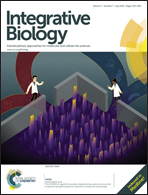Using reconfigurable microfluidics to study the role of HGF in autocrine and paracrine signaling of hepatocytes†
Abstract
Cancer, developmental biology and tissue injury present multiple examples where groups of cells residing in close proximity communicate via paracrine factors. It is nearly impossible to dissect such cellular interactions in vivo and is quite challenging in vitro. The goal of this study is to utilize a reconfigurable microfluidic device in order to study paracrine signal exchange between groups of primary hepatocytes in vitro. Previously, we demonstrated that hepatocytes residing on protein spots containing collagen and hepatocyte growth factor (HGF) spots expressed epithelial (hepatic) phenotypes and also rescued them in neighboring hepatocytes on collagen spots that did not receive direct HGF stimulus. Herein, we designed a microfluidic device with parallel fluidic channels separated by retractable (reconfigurable) walls and employed this device to investigate interactions between groups of HGF-stimulated and unstimulated hepatocytes. Using a novel reconfigurable microfluidic device, we demonstrate that cultivation of HGF-containing protein spots upregulates the production of endogenous HGF in hepatocytes and that these HGF molecules diffuse over, causing phenotype enhancement in the recipient cells. We also show that selective treatment of the recipient hepatocytes with a c-met inhibitor (SU11274) diminishes the rescue effect, as gauged by the down-regulation of albumin and HGF expression. Our study is one of the first to demonstrate paracrine signaling via HGF in primary hepatocytes. More broadly, tools and methods described here may be used to study paracrine signaling in other types of cells and will have relevance for various fields of biomedical research from cancer to immunology.


 Please wait while we load your content...
Please wait while we load your content...